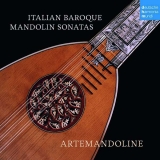 Italian Baroque Mandolin Sonatas (Abate Ranieri Capponi: Sonate VIII & XII; Niccolo Susier: Sonata per Mandola; Nicola Romaldi: Sonata per Mandola; Giovanni Pietro Sesto da Trento: Sonata di Mandolino; Francesco Piccone: Sinfonia per la Mandola); Artemandoline (Juan Carlos Munoz, Mari Fe Pavon, Mandolinen, Manuel Munoz, Gitarre, Ulrik G. Larsen, Theorbe, Oleguer Aymami, Cello, Jean-Daniel Haro, Kontrabass & Violine, Ralf Waldner, Orgel & Cembalo); 1 CD Deutsche Harmonia Mundi; Aufnahme 08/2019, Veröffentlichung 12/02/2021 (55'40) – Rezension von Remy Franck
Italian Baroque Mandolin Sonatas (Abate Ranieri Capponi: Sonate VIII & XII; Niccolo Susier: Sonata per Mandola; Nicola Romaldi: Sonata per Mandola; Giovanni Pietro Sesto da Trento: Sonata di Mandolino; Francesco Piccone: Sinfonia per la Mandola); Artemandoline (Juan Carlos Munoz, Mari Fe Pavon, Mandolinen, Manuel Munoz, Gitarre, Ulrik G. Larsen, Theorbe, Oleguer Aymami, Cello, Jean-Daniel Haro, Kontrabass & Violine, Ralf Waldner, Orgel & Cembalo); 1 CD Deutsche Harmonia Mundi; Aufnahme 08/2019, Veröffentlichung 12/02/2021 (55'40) – Rezension von Remy Franck
Mit Ausnahme der Sonate von Francesco Piccone sind alle Interpretationen dieser CD von Artemandoline (laut Verlagsangaben) Weltersteinspielungen. Gefunden wurden diese Sonaten in der Library of Congress in Washington, in den Konservatorien von Mailand und Florenz, sowie in der Diözesanbibliothek in Münster.
Das herausragend gute Ensemble spielt somit ein abwechslungsreiches Programm, das die Mandoline in der südländischen Diaspora belässt, aber in der Interpretation durchaus erfrischend neue Wege geht, weit weg von Salonmusik. Mit manchmal überraschenden Akzenten und Verzierungen sowie unerwarteten Nuancen schafft es Artemandoline, uns die Werke nicht konsumieren zu lassen, sondern zwingt uns, ihnen wirklich zuzuhören und ganze neue, kräftige Klangfarben und selbst in Largo-Sätzen spannende Rhythmen zu entdecken.
With the exception of the sonata by Francesco Piccone, all the interpretations on this CD by Artemandoline are (according to the publisher) world premiere recordings. These sonatas were found in the Library of Congress in Washington, in the conservatories of Milan and Florence, and in the diocesan library in Münster.
The outstandingly good ensemble thus plays a varied program that leaves the mandolin in the southern diaspora, but in its interpretation definitely goes refreshingly new ways, far away from salon music. With sometimes surprising accents and embellishments as well as unexpected nuances, Artemandoline manages not to let us consume the works, but forces us to really listen to them and discover new, powerful timbres and even in Largo movements exciting rhythms.






















